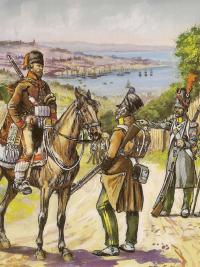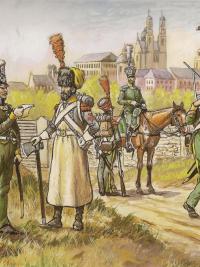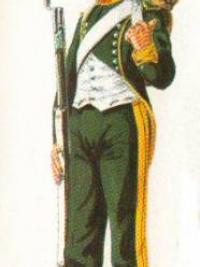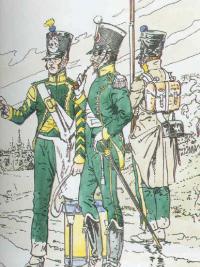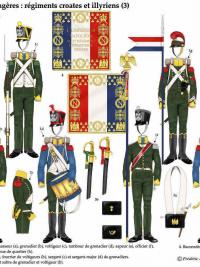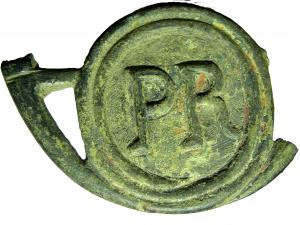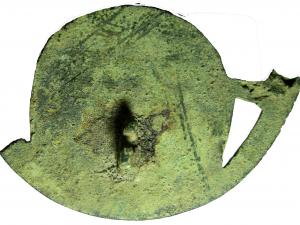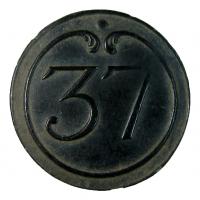Хорватские (Кроатские) полки - Rеgiments croates
Хорватские (Кроатские) полки.
По окончании кампании 1809 года, закончившейся сокрушительным поражением Австрии, 14 октября 1809 года был заключён Шённбрюнский мирный договор.
Французская Империя получила под свою власть часть военной границы Австрийской Империи. Эту часть территории назвали « Военной Хорватией » (Le Croatie militaire), на её территории оставались шесть сформированных австрийцами для защиты границ от турок, черногорцев и албанцев граничарских (Grenzer) или провинциальных полков (1-й, 2-й, 3-й, 4-й, 10-й и 11-й) и два Иллирийских ( ILLyrian) батальона общей численностью 16 518 человек, поступивших на французскую службу под общим названием «Иллирийских егерей» (Illyrian Chasseurs). Эти части преобразовали по образцу французской лёгкой пехоты.
Хорваты сохранили свои коричневые однобортные мундиры венгерского образца (с 10 пуговицами) и австрийские кивера, командование полками приняли на себя французские офицеры:
-- 1-й Личанский полк (Lika) – полковник Сливарич фон Гельденбург (Marc Slivarich von Heldenbourg);
-- 2-й Отточанский полк (Ottochatz) – полковник Мейнадье (Louis-Henri-Rene Meynadier), в 1810 году – полковник Винтер (Pierre Winter), в 1812 году – полковник Гордон (Robert Gordon);
-- 3-й Огулинский полк (Ogulin) – полковник Серрант (Joseph Serrant), в 1811 году – полковник Голевац (Xavier Holevatz);
-- 4-й Слуинский полк (Sluin) – полковник Сулье (Jacques-Robert Souslier, Baron de Choisy), в 1812 году – полковник Голевац;
-- 5-й Глинский полк (Glina) – полковник Жоли (Etienne Joly); 6-й Петринский полк (Petrina) – полковник Буден (Jacques-Jean-Marie-Francois Boudin, Comte de Tromelin).
Каждый полк состоял из двух батальонов по шесть рот (карабинерная, вольтижёрская и четыре егерских), артиллерийского батальона (50 артиллеристов) и штаб-квартиры.
По предложению генерал-губернатора Иллирийских провинций (Provinces Illyriennes) маршала Мармона (Auguste-Frederic Marmont) и Высочайшему повелению от 22 мая 1810 года солдаты хорватских полков получили чёрные французские кивера, украшенные ромбовидной пластиной белого металла с полковым номером, французской кокардой и шарообразным помпоном ротных цветов, серую шинель, тёмно-синие брюки, чёрные короткие гетры, синие жилеты и синие однобортные мундиры лёгкой пехоты (с 1811 года – зелёные) французского образца с 9 пуговицами и облицовкой полковых цветов: 1-й полк – алый, 2-й полк – малиновый, 3-й полк – жёлтый, 4-й полк – оранжево-жёлтый, 5-й полк – голубой, 6-й полк – зелёный (замена униформы проходила медленно и некоторые солдаты оставались в старых австрийских мундирах вплоть до 1813 года), на вооружении ружьё и сабля лёгкой пехоты с красным темляком и белой кистью. У офицеров серебряные эполеты и знаки различия в виде накладок на киверах, у барабанщиков солдатские мундиры с жёлтым галуном по воротнику, отворотам и погонам (ласточкины гнёзда на красной подкладке), 6 горизонтальных шевронов на рукавах.
Для пополнения пограничных личного состава полков в 1811 году в Карловаце (Karlovac) было сформировано Военное училище на 200 студентов, которые позднее были отправлены во Францию для окончания подготовки.
В 1811 году из личного состава 1-го и 2-го пограничных полков был сформирован 1-й временный хорватский пехотный полк (1er Regiment provisoire Croate), который принимал участие в Русской кампании 1812 года и Саксонской кампании 1813 года, из 3-го и 4-го полков в 1813 году образован 2-й временный хорватский пехотный полк (2e Regiment provisoire Croate), участвовал в сражениях при Радебурге (Radeburg) и Вюршене (Wurschen), в конце 1813 года расформирован; из солдат 5-го и 6-го пограничных полков в 1811 году сформирован 3-й временный хорватский пехотный полк (3e Regiment provisoire Croate), участвовал в Русском походе, в 1813 году расформирован; 4-й временный хорватский пехотный полк (4e Regiment provisoire Croate) сформирован в 1813 году на базе 5-го и 6-го пограничных полков, в том-же году чины полка включены в состав 2-го колониального батальона.
Rеgiments croates
The Tenbrunsel Peace Treaty was concluded on the 14th October 1809 at the end of the campaign of 1809 that was ended by a crushing defeat of Austria.
French Empire gained the power over the part of the military border of the Austrian Empire. This part of the territory was called "The Military Croatia" (Le Croatie militaire). In its territory there were 6 Grenzer or provincial regiments (the 1st, the 2nd, the 3rd, the 4th, the 10th and the 11th) and two ILLyrian battalions. They were formed by the Austrians (16518), who were entered the French service under the general name "Illyrian Rangers" (Illyrian Chasseurs) to protect the borders from the Turks, Montenegrins and Albanians.
These parts were transformed by the model of the French light infantry.
Croats have kept their brown single-breasted uniform of the Hungarian sample (it had 10 buttons) and Austrian shako. The command of regiments was taken by the French officers:
-- Colonel Sliverish von Waldenburg (Marc Slivarich von Heldenbourg) from the 1st Lishansky regiment (Lika);
-- Colonel Since (Louis-Henri-Rene Meynadier), in 1810 it was Colonel Winter (Pierre Winter), in 1812, Colonel Gordon (Robert Gordon) from the 2nd Altoconsky regiment (Ottochatz);
-- Colonel Serrant (Joseph Serrant), in 1811 it was Colonel Holevas (Xavier Holevatz) from the 3rd Gulinski regiment (Ogulin);
-- Colonel Soulier (Jacques-Robert Souslier, Baron de Choisy), in 1812 it was Colonel Holevas from the 4th Slowinski regiment (Sluin);
-- Colonel Joly (Etienne Joly from the 5th Glinski regiment (Glina));
-- Colonel Boudin (Jacques-Jean-Marie-Francois Boudin, Comte de Tromelin) from the 6th Petri regiment (Petrina).
Each regiment was consisted of two battalions which included six companies (Colonel, voltizers and four ranger’s brigades), an artillery battalion (50 gunners) and headquarters.
On the suggestion of may 22, 1810 of Lieutenant-Governor, of the Illyrian provinces (Provinces Illyriennes), Marshal Marmont (Auguste-Frederic Marmont) and the Highest command, the soldiers of the Croatian regiments got black French shako, that was decorated with diamond-shaped plate of white metal with the regimental number, the French cockade and spherical pompon regimental colors. There also was gray overcoat, dark blue pants, short black socks, blue jackets and blue(1811 - green) single-breasted uniform of light infantry, that was done by French sample with 9 buttons and regimental facing colors: red for the 1st regiment , crimson for the 2nd regiment, yellow for the 3rd regiment, orange-yellow for the 4th regiment, blue for the 5th regiment, green for the 6th regiment (the replacement of uniforms has been slow and some soldiers were remained in the old Austrian uniform until 1813). The soldiers were armed with guns and swords of the light infantry with red sword knot and white handle.
The officers had silver epaulettes and the insignia of the form of linings on the shakos. The marching soldiers’ uniform was with yellow braid on the collar, lapels and epaulettes and 6 horizontal chevrons on the sleeves.
To replenish the border guards of personnel regiments in 1811 in Karlovac (Karlovac) there was formed a Military school for 200 students, who were later sent to France to complete the training.
In 1811 the 1st temporary Croatian infantry regiment (1er Regiment provisoire Croate) was formed of the personnel of the 1st and the 2nd border guard regiments. This regiment took part in the Russian campaign of 1812 and the Saxon campaign of 1813. The 2nd temporary Croatian infantry regiment (2e Regiment provisoire Croate)was formed from the 3rd and the 4th regiments in 1813. This regiment participated in battles in Radeburg (Radeburg) and in Versene (Wurschen). At the end of 1813 it was disbanded. The 3rd temporary Croatian infantry regiment (3e Regiment provisoire Croate) was formed from the soldiers of the 5th and the 6th regiments in 1811. It participated in the Russian campaign. In 1813 it was disbanded. The 4th temporary Croatian infantry regiment (4e Regiment provisoire Croate) was formed in 1813 on the basis of the 5th and 6th border regiments. In the same year the ranks of the regiment was included in the 2nd colonial battalion.
There is currently no content classified with this term.
Social

